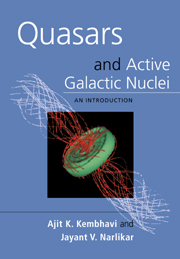Book contents
- Frontmatter
- Contents
- Preface
- Acknowledgments
- Acronyms and abbreviations
- 1 HISTORICAL BACKGROUND
- 2 THE COSMOLOGICAL FRAMEWORK
- 3 RADIATIVE PROCESSES–I
- 4 RADIATIVE PROCESSES–II
- 5 THE STANDARD MODEL
- 6 SURVEYS
- 7 LUMINOSITY FUNCTIONS
- 8 THE CONTINUUM
- 9 RADIO PROPERTIES
- 10 X-RAY EMISSION
- 11 X-RAY AND GAMMA-RAY SPECTRA
- 12 UNIFICATION
- 13 QUASAR ABSORPTION LINES
- 14 GRAVITATIONAL LENSING
- 15 PROBLEMS AND CONTROVERSIES
- References
- Books, reviews and proceedings
- Author index
- Subject index
5 - THE STANDARD MODEL
Published online by Cambridge University Press: 05 June 2012
- Frontmatter
- Contents
- Preface
- Acknowledgments
- Acronyms and abbreviations
- 1 HISTORICAL BACKGROUND
- 2 THE COSMOLOGICAL FRAMEWORK
- 3 RADIATIVE PROCESSES–I
- 4 RADIATIVE PROCESSES–II
- 5 THE STANDARD MODEL
- 6 SURVEYS
- 7 LUMINOSITY FUNCTIONS
- 8 THE CONTINUUM
- 9 RADIO PROPERTIES
- 10 X-RAY EMISSION
- 11 X-RAY AND GAMMA-RAY SPECTRA
- 12 UNIFICATION
- 13 QUASAR ABSORPTION LINES
- 14 GRAVITATIONAL LENSING
- 15 PROBLEMS AND CONTROVERSIES
- References
- Books, reviews and proceedings
- Author index
- Subject index
Summary
Introduction
The early ideas of Hoyle and Fowler (1963) concerning gravitational collapse to a compact object that would serve as an energy reservoir for a quasar found a modified expression in the black hole accretion disk paradigm, a few years later. This paradigm had been invoked and worked well in the understanding of binary X-ray sources in the Galaxy. In the binary star context the compact member is taken to be either a neutron star or a black hole with mass of stellar order. For quasars and AGN, the compact masses would have to be several orders of magnitude higher, as already pointed out by Hoyle and Fowler (1963). The scenario here had therefore to explain how such objects form in the first place, how they generate an accretion disk and jets, and how and with what efficiency is the gravitational energy converted to the observed radiant energy.
In this brief review of the current thinking on the subject we shall follow the excellent account given by Rees (1984) whose basic tenets have remained more or less the same since then.
The formation of a massive black hole
As first pointed out by Hoyle and Fowler (1963), the energy source of a quasar or AGN is gravitational and could arise from a highly collapsed object or a massive black hole. This much is broadly agreed by most workers in the field. The question is, in the first place how does a collapsed massive object come about?
- Type
- Chapter
- Information
- Quasars and Active Galactic NucleiAn Introduction, pp. 101 - 121Publisher: Cambridge University PressPrint publication year: 1999



